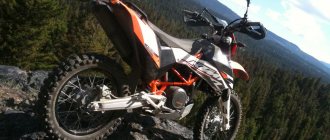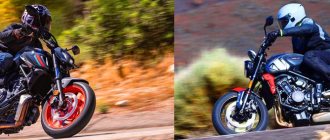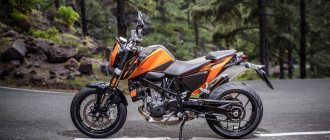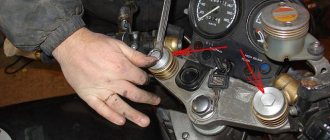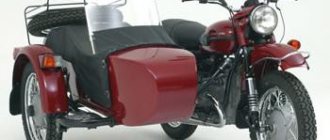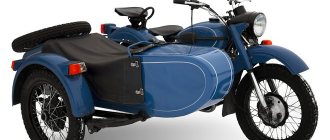“Dnepr” has been produced at the Kiev motorcycle plant since the mid-twentieth century. In Soviet times, it was popular along with Ural technology and was its direct competitor. Now the Irbit plant has stopped producing its motorcycles, but the Kiev plant still produces new models, such as Solo and KM38 . They have earned popularity due to their reliability and power. Repairing the Dnepr engine is quite simple, which allows it to be done even while traveling.
All bikes from the Kyiv plant have good dynamics and a pleasant sound, which is often compared to Harley. It was possible to attach a stroller to the main part, however, due to production cuts, models without additional seats or equipment for agriculture are currently being produced.
The most popular model is the Dnepr 11; engine tuning is presented in the 11M model, slightly modified with higher performance. Engine type: four-stroke carburetor, overhead valve with air cooling system. The two-cylinder Dnepr, whose engine capacity is 649 cm3, produces quite good power of 32 horsepower. The speed is 105 km/h according to the passport, but in reality it is about 120.
The gearbox of the Soviet bike has a dry, double-disc clutch and four stages. Assembling the Dnepr 11 engine with such a gearbox is not a problem. Moreover, it is very reliable and rarely causes problems.
If your motor makes excessive noise during operation, it means there is a problem with it that needs to be corrected immediately. Everyone has encountered problems in the engine itself and has already faced more than once what a Dnepr engine assembly is. However, few people encounter problems with the box. Therefore, let's talk about what issues may arise during the operation of the checkpoint and how to solve them.
At the first symptoms of self-shutdown, excessive gear noise, or when the next gear is not engaged, the motorcycle jerks or jolts. It is impossible to carry out repairs where necessary. Parts must be kept clean, since dirt and dust have a very negative effect on engine performance.
Dnepr motorcycle engine repair is directly related to the gearbox . However, unlike many motorcycles, it is not necessary to remove both units. The box is removed separately. To do this, the wheel, driveshaft with rear axle, separate the clutch cable and neutral wire. Then disconnect the air filter and drain the oil. After this, you can disconnect the unit from the motor.
Story
Currently, the production of motorcycles has been completely stopped, the plant is being repurposed into a business center, the equipment is being cut and sold for scrap.
Often, many people confuse KMZ Dnepr motorcycle models with IMZ Ural models due to the visual similarity of the designs.
Dnepr is a heavy road motorcycle with a sidecar, produced by KMZ - Kyiv Motorcycle Plant.
Nowadays, all heavy KMZ motorcycles are collectively called “Dnepr”, although the first model to receive its own “Dnepr” K-650 appeared in 1968.
The history of the creation of Dnepr motorcycles has passed a difficult path. After the end of the Great Patriotic War, the country experienced widespread devastation in all spheres of life. Nevertheless, it was necessary to somehow normalize not only the everyday life of citizens, but also the restoration of various production.
The Kiev Motorcycle Plant was one of the first enterprises where normal production was established, with very good prospects for development. It is clear that the first stages of development were very difficult, but the more valuable are the achievements that were shown by the plant’s employees from the very beginning of work and over the years.
Starting from the first stages of its activity, all employees of the Kyiv Motorcycle Plant were busy studying various technical data that could be useful in the production of the first motorcycle in the history of the enterprise - Kievlyanin. The plant itself was formed, thanks to decrees of the Council of People's Commissars No. 2435 - 652 of September 1945, on the basis of the Armored Repair Plant No. 8 on the street. Kagatnaya (currently Khokhlov Family Street). Initially, this model was produced at another plant, but since 1947, all main types of work on the design and manufacture of this motorcycle were carried out at the Kiev Motorcycle Plant.
The year 1947 was notable for the fact that at the Dnepr motorcycle plant they began to develop a new motorcycle on three wheels, simultaneously expanding production workshops aimed at improving the motorcycle industry. In 1949, about a hundred workers and specialists who had previously worked at another production enterprise came to the plant, which was a good help for the implementation of further plans for the manufacture and sale of the M-72 motorcycle. This model had a 4-stroke engine with two cylinders, a power of approximately 22 hp, a volume of 750 cm3 and a speed of 85 km/h. The M-72 was very popular, the rate of its production increased every year, which led to the idea of designing a new type of motorcycle - the M-53. The designer Pozdnyakov K.A. took on the implementation of this task. In addition, work continued to improve existing technologies, develop new seats and improve the braking system.
Since 1953, the Dnepr motorcycle plant finally came under the control of the Ministry of Mechanical Engineering. In 1956, more modernized motorcycles of previous models began to be produced - K-750SM and M-53S. They were produced in fairly wide quantities, at least fifty thousand copies per year, which continued until 1970. In addition, these models participated in various competitions in the GDR, bringing their country several gold models and a team first place. Compared to previous models, power has been increased to 26 hp, while fuel consumption has been reduced.
Another achievement of the Kyiv Motorcycle Plant was the K-750M model with a power of 27 hp. The main features of the new motorcycle are a more powerful generator and improved relay control technology. In addition, additional innovations were provided to make the driving process easier for the driver. In particular, the motorcycle was equipped with a distant view mirror and mudguards for the driver.
In 1967, the plant produced the first batch of the Dnepr motorcycle. It was equipped with a two-cylinder engine with a volume of 650 cm3. In addition, the Dnepr motorcycle could reach a speed of 100 km/h with an engine power of 32 hp. The Dnepr motorcycle engine was of the overhead valve type, at 5000 rpm. In connection with the large production of these motorcycles, which reached 25-26 thousand copies per year, a decision was made to further expand the factory buildings and re-equip them, aimed at the production and production of Dnepr motorcycles. This reconstruction made it possible to maintain the production rates that were necessary for the full sale of these motorcycles.
The year 1971 was notable for the fact that the Kiev plant produced the 500,000th copy of the Dnepr “MT-9” model. Just three years later, it was decided to produce another, more modern model of the Dnepr - “MT-10”. The main difference from the previous model was the presence of new equipment, 12V power, as well as a 200 W generator. In addition, the MT-10 had a 4-stroke engine with a displacement of 650 cm3. When equipped with a sidecar, this motorcycle could reach a speed of 100 km/h. Since 1977, we launched the production of Dnepr motorcycles with increased engine power. They were called that way - MT-10-36, where the last digit indicates the amount of horsepower in the engine. This model was more advanced in terms of comfort and practicality compared to previous models.
Over the entire period of its development, the Kiev Motorcycle Plant has established supplies of its equipment to many countries around the world, including Germany, Holland, Argentina, Cuba, Switzerland and many others. Such an expanded geography of potential buyers led to the launch of new motorcycle models in 1985 - Dnepr 11 and Dnepr 16. The Dnepr 11 motorcycle included a 4-stroke engine with two cylinders. The characteristics of the Dnepr 11 motorcycle were incomplete without mentioning the engine power, which became even greater - 38 hp. In addition, this motorcycle had increased speed indicators - approximately 125 km/h.
Dnepr 16 was first released in the mid-80s of the last century. The MT-10 motorcycle was taken as a basis, but some additional nuances were added. In particular, engine power and speed indicators were increased. Compared to the MT-11, the Dnepr 16 had a lower speed, but it had a sidecar wheel drive. The loss in speed was a minor problem, because these motorcycles were not initially considered racing models, and attention was paid primarily to the versatility and endurance of the entire motorcycle design.
Source
Habitability
Passengers in a motorboat like the Dnepr will feel comfortable, “like at home.” Among its contemporaries, the vessel is the most comfortable to use, as it is equipped with semi-soft seats and an aft sofa. For greater convenience, some owners install roof rails.
The two front soft seats can be moved lengthwise and crosswise. The tilt angle of the backrests varies in three modes. If you want to go fishing or relax on the shore, you need to loosen the screws and take the chairs with you. When they become outdated or fail, replacing them is not difficult. Specialized stores have seats and boat rails for sale.
Behind, on a sofa with a comfortable backrest, three people can fit in a sitting position. If necessary, you can use this furniture for relaxing or sleeping. The overnight accommodation is formed in this way: the chairs located in the bow are folded out. Next, you should insert the back of the aft sofa into the resulting free space between them. You can get a soft bed for two or three people. Everything goes back together easily and in a couple of minutes. Typically, owners like side cabinets for storage. They allow you to keep everything you need at hand.
History of creation
In the post-war years, against the backdrop of general devastation, it was necessary to restore the production sector. The Kiev Motorcycle Plant was among the first to restore the production process and, despite enormous difficulties, new equipment began to roll off the assembly line.
In 1947, the Dnepr motorcycle plant began to develop new three-wheeled motor vehicles. Production expanded and after 2 years the plant’s staff was joined by hundreds of representatives from another company, which was very useful when planning the production of M-72 motorcycles. This equipment was equipped with a four-stroke two-cylinder engine. It became very popular, and therefore the decision was made to create a new, improved model, the M-53.
M-72 motorcycle with a DP machine gun in the motorcycle museum
Since 1956, production of the modernized K-750SM and M-53S motorcycles began. They were produced until 1970.
Since 1967, the plant began producing the first batch of Dnepr motorcycles. It was equipped with a two-cylinder engine with a capacity of 650 cc. cm and power 32 hp. Large production volumes gave rise to the expansion of production facilities and their re-equipment.
MT8 engine of the Dnepr K-650 motorcycle
is a four-stroke air-cooled carburetor engine.
The engine uses an overhead valve timing mechanism, a cast crankshaft made of high-strength cast iron with removable lower connecting rod heads and replaceable connecting rod bearing shells. The design uses automotive-type inserts, interchangeable with the inserts of the Moskvich-408 car. The engine uses a forced lubrication system with centrifugal oil purification; bimetallic cylinders are used, which are more efficient than cast iron. Due to this, the engine has low thermal stress; the pistons in the cylinder are installed with a gap of 0.05 - 0.07 mm. The engine is reliable and durable.
Popular models and their technical characteristics
The basis for the creation of the Dnepr motorcycle plant was an armored tank plant. The motor vehicles produced were not very maneuverable, but were popular among citizens. During the existence of the enterprise, various modifications of Dnepr motorcycles were produced.
The first Dnepr motorcycles appeared in 1967. The K-650 model was equipped with a powerful 650 cc engine, and thanks to the good sales dynamics of the motorcycle, its widespread production was established.
Dnepr K-650
The beginning of the 70s was marked by the release of modifications MT-9 and MT-10 . Their seats had modernized shapes, the fuel tanks and gearbox were improved.
Dnepr M-9
Since 1976, the Kiev Motorcycle Plant began producing a limited version of the MT-10 with chrome parts, which is still popular among connoisseurs of Soviet technology. This modification has become faster (up to 130 km/h), while providing reliable traction even in winter thanks to powerful studded wheels.
Since 1977, the previous version has been replaced by improved modifications MT10-36 and MT-12 .
Dnepr MT-10-36
The more popular models Dnepr 11 and Dnepr 16 had a more impressive load capacity (up to 260 kg), sidecar brakes, excellent maneuverability and speed performance. Motorcyclists still use this technology to travel around rural areas and in the city.
The Dnepr-11 model was equipped with a four-stroke two-cylinder engine, and the engine power was 38 hp. This motorcycle could reach speeds of up to 125 km/h.
Watch a video review of the Dnepr-11 motorcycle:
The Dnepr-16 motorcycle was based on the MT-10 vehicle model with additional modifications. The engine became more powerful and the maximum speed increased. The Dnepr-16 had a lower speed than the MT-11, but the sidecar wheel was equipped with a drive. The reduced speed indicators were not critical, because the motor vehicle was not considered a racing vehicle. Versatility and endurance deserved more attention.
Dnepr-16
In 1991, they released the Dnepr Solo Motorcycle (KMZ-8.157-01) - a single version, used without a sidecar, with a power of 23.5 hp. With. It was equipped with a two-cylinder engine with a capacity of 649 cc. see Speed indicators - more than 125 km/h.
Dnepr Solo
In the early 90s, there was a decrease in production volumes of Dnepr motor vehicles. However, new motorcycles are still appearing now in the form of road single motorcycles, endurros, choppers, three-wheeled heavy motorcycles and other varieties.
Appearance and design features
The hull of the “Dnepr” model stands out among its fellows with its sharp chine in the bow, which makes it possible to achieve relatively high speeds (up to 32-37 km/h), increased stability during planing and a reduced draft. The disadvantage of this model, with an increased bottom deadrise, is that it rolls when parked. The outer angle at the transom reaches 14.5°. The owners of the vessel deal with the flooding of water in stormy weather at the anchorage by altering the transom to accommodate a high leg and sealing the recess hatch. The body is made of duralumin parts, connected by rivets with a thiokol gasket that prevents moisture leakage. The weak side of this metal is significant - it is not welded with electricity or argon, but is only riveted. Therefore, the beginning of each season is not complete without checking the condition of the rivets and replacing the most unreliable ones. They tend to become loose when the bottom hits the water. Which, in turn, leads to metal deformation and the appearance of cracks. The composition of the cross set is AMG alloy. The sides are sheathed with one-millimeter metal, and the plating surfaces of the transom, deck and bottom are 1.5 mm thick. Transom - the main technical characteristics of the Dnepr depend on it. To the credit of the developers, the design of the transom, stamped from a single sheet of metal, is quite rigid. However, most owners unanimously believe that it is unfinished. The volume of the sub-engine niche is not enough to accommodate two engines. The second is needed for quiet running and has less power.
Video of the Dnepr boat:
Advice: either re-equip the transom for two electric motors, completely changing the entire reinforcement scheme of the transom board, or carry a spare one with you and re-weigh it if necessary.
The motorboat is equipped with a convex windshield, consisting of two halves connected at the central pillar. The front edge of the awning is attached with a cord to the rigid edging of the windshield. The running awning can be attached in such a way that the back and sides are open. The steering can be placed both on the right and on the left, adjusting the internal space to suit you. The right-hand drive installation of the remote control is capable of compensating for the roll of the vessel when turning. Overall, the cockpit layout is not as functional as it could be. For greater buoyancy, the bow of the glider is equipped with a pressurized compartment that occupies a large space. As a result, the dry luggage compartment is too small. Access to it is easy: opening the aft bulkhead that separates the trunk from the cockpit. A small compensation for the lack of usable space is the presence of side lockers between the fifth and sixth frames. They fit everything that needs to be at hand. The plywood floor in the cockpit is solid and does not provide access to the volumetric space underneath, sufficient for cargo placement. Therefore, Dnieper motor boats cannot boast of cargo capacity. The width, dimensions and dimensions of the Dnepr boat are quite compact. Payol consists of boat plywood, which does not weigh down the model. The motorboat has a carrying handle at the back.
Tuning options
Due to the closure of the Kyiv Motorcycle Plant, the modernization and modification of this motorcycle equipment has been suspended. In this regard, all improvements have to be done with your own hands or contact private specialists.
Tuning areas
The exhaust system, front fork, roll bar, footrest, and windshield are most in need of replacement. Forks, footrests and other body parts are replaced with chrome-plated counterparts.
When the exhaust system is modernized, they often install nickel-plated elbows and a direct-flow muffler. Such replacements will improve engine performance and make it sound better. Some motorcyclists, instead of reverse gear, provide the device with an additional gear in order to increase the dynamics of the motorcycle.
In the video below you can see step-by-step instructions for converting a standard gearbox into a five-speed one:
The ignition system requires modification. For this purpose, the motor vehicle is equipped with an electric starter for automatic engine start and contactless ignition. The most effective effect will be replacing the engine with a new, more powerful one. Such changes will cost a significant amount because the new engine comes with additional parts and equipment.
Appearance
Due to the large dimensions of the motorcycle, in order to give it dynamism and update its external qualities, they resort to replacing some parts of the body in the form of standard shock absorbers, steering gear, footpegs, forks and other parts with lighter analogues. Often, to update the appearance, parts are repainted in a different color.
Engine tuning
During the modernization process, the motor must be thoroughly cleaned. The exhaust system is equipped with various nickel rings and a forward flow system. These actions are important not only for aesthetics, but also for engine performance.
If it is not possible to buy nickel-plated parts, then you can contact a specialist to coat the metal parts with nickel.
Frame and body tuning
The frame design of all modifications is similar. The frame at the back can be lengthened (by 15-20 cm) to give your legs more freedom. In this case, it is also necessary to lengthen the driveshaft - then the frame is lengthened in accordance with the height of the driver.
To get a similar fit to classic American choppers, you need to lengthen the frame at the front. Then the cardan shaft does not change, you just need to redo the pedals.
The tuning capabilities of the Dnepr motorcycle are demonstrated in this video:
Many owners of the Dnepr motorcycle have a special affection for it and, despite the huge selection of modern motorcycle equipment, are not going to change their preferences. Now there are many opportunities to update a vehicle by tuning it.
Source
Scheme
The development engineers wanted to achieve excellent wave penetration, high speed and maneuverability. Therefore, all performance motorboats are designed in such a way as to fulfill the assigned tasks: a high keel makes it easier to control and increases dynamic stability. Sharp forms of corrugations on the deck and side sheets, landing in the under-engine niche improve the quality of planing and the speed of the planer.
Speed table
Below are the speed data with imported and domestic engines in fresh water with a temperature of 15 to 20 degrees.
| No. | Motor | Screw | Number of propellers (motors) | Loading, kg | Revolutions, 1/min | Speed, km/h |
| 1 | Mercury 30 | Solas_10_12 | 1 | 400 | — | 41 |
| 2 | Mercury F 25 | Merc_99_13 | 1 | 120 | 4700 | 41 |
| 3 | Mercury F 25 | Solas_99_11 | 1 | 210 | 5000 | 38 |
| 4 | Mercury F 30 | Merc_105_11 | 1 | 120 | 6050 | 43 |
| 5 | Mercury F 30 | Merc_111_13 | 1 | 120 | 5150 | 46 |
| 6 | Suzuki DF 50 | Suzuki_114_15 | 1 | 120 | 6800 | 63 |
| 7 | Suzuki DT 15 C | Suzuki 9 1/4_9 | 1 | 90 | 5250 | 32 |
| 8 | Suzuki DT 15 C | Suzuki 9 1/4_9 | 1 | 175 | 5150 | 30 |
| 9 | Suzuki DT 15 C | Suzuki 9 1/4_9 | 1 | 260 | 4950 | 26 |
| 10 | Suzuki DT 15 C | Suzuki 9 1/4_9 | 1 | 345 | 4800 | 22 |
| 11 | Tohatsu (Nissan) 18 | Tohatsu_93_9 | 1 | 90 | 5500 | 36 |
| 12 | Tohatsu (Nissan) 18 | Tohatsu_93_9 | 1 | 165 | 5350 | 33 |
| 13 | Tohatsu (Nissan) 18 | Tohatsu_93_9 | 1 | 250 | 5130 | 30 |
| 14 | Tohatsu (Nissan) 18 | Tohatsu_93_9 | 1 | 340 | 5100 | 29 |
| 15 | Tohatsu (Nissan) 18 | Tohatsu_93_9 | 1 | 420 | 4800 | 17 |
| 16 | Tohatsu 30 | Rascal 10 3/8_11 | 1 | 120 | 5400 | |
| 17 | Tohatsu 30 | Rascal 10 3/8_11 | 1 | 450 | 5150 | |
| 18 | Tohatsu 30 | Tohatsu_99_12 | 1 | 230 | 5200 | |
| 19 | Tohatsu 30 | Tohatsu_99_13 | 1 | 230 | 5100 | |
| 20 | Tohatsu 30 4str | Solas_99_11 | 1 | 120 | 5900 | 43 |
| 21 | Tohatsu 30 4str | Tohatsu_99_13 | 1 | 120 | 5300 | 46 |
| 22 | Yamaha 30 2.08 | Yamaha 9 7/8_13 | 1 | 90 | 5000 | 43 |
| 23 | Yamaha 30 2.08 | Yamaha 9 7/8_13 | 1 | 175 | 4700 | 38 |
| 24 | Yamaha 30 2.08 | Yamaha 9 7/8_13 | 1 | 260 | 4700 | 38 |
| 25 | Yamaha 30 2.08 | Yamaha 9 7/8_13 | 1 | 345 | 4200 | 34 |
| 26 | Yamaha 40 2.0 | Yamaha 11 1/8_13 | 1 | 100 | 56 | |
| 27 | Yamaha 40 2.0 | Yamaha 11 3/8_12 | 1 | 300 | 44 | |
| 28 | Whirlwind-25 | Whirlwind_240_300 | 1 | 100 | 37 | |
| 29 | Whirlwind-25 | Whirlwind_240_300 | 1 | 352 | 33 | |
| 30 | Whirlwind-30 | Whirlwind_240_320 | 1 | 290 | 43 | |
| 31 | Whirlwind-30 | Whirlwind_240_320 | 1 | 385 | 39 | |
| 32 | Neptune-23 | Neptune_230_280 | 1 | 120 | 30 | |
| 33 | Neptune-23 | Neptune_230_280 | 1 | 210 | 27 | |
| 34 | Neptune-23 | Neptune_230_280 | 1 | 300 | 17 |
Disassembly procedure
- Wash the gearbox well with cleaning agent and place it on a hard surface.
- First you need to reset the kickstarter spring tension.
- Disconnect the clutch lever and remove the slider with the rubberized ring.
- Now you need to remove the kickstarter, with all its attachments (clutch tips, bearings and wedge).
- Remove the pin, then unscrew the disk nut on the rubber coupling.
- Unscrew the bolts securing the back cover of the box.
- When the box is disassembled, all that remains is to find the problematic part and replace it, and then reassemble it, after washing the gearbox from the inside.
As you can see, parsing the basic elements is very simple and quick. But what to do if you want to perform engine tuning on Dnepr 11?
Question about compression
Friends, please tell me what the compression should be on modern 750 cm3 engines (you can immediately tell me for 650 cm3)? I became the owner of a compression meter, now I need to check the pots. If anyone needs to measure the velcom.
on a 650cc from 8-10 it’s bad, less than 6 is no longer good, the difference between the cylinders is no more than 1, then look at the rings, the bug.
Thanks, we sorted out the 650 cm3, does anyone have any information on 750 cm3 engines?
Well, you need to kick the kick more energetically)))). My compression gauge clearly states “at least 300 rpm”
Now through the Dnieper box I kicked 8 in both.
I will measure with a tool. The Gear Up has a starter, on his older brother I will remove the engine and turn it with a screwdriver (I do not remove it to measure compression, I will carry out the measurement for prevention).
Compression is measured in the same way as on a car: Unscrew all the spark plugs, fully open the throttle (required!), and turn it on for 3-4 seconds. starter (kick 5-6 times). On a car, you must remember to throw off the central wire from the coil to ground (ground), or (injector) turn off the connector. On 650s, compression of 5 atm is acceptable, the engine runs fine. The main thing is that the difference between the pots does not exceed one atm. On a newly assembled 750 with Mazda rings, I measured 11.5 and 11. Later, these figures dropped slightly to 10.5-10.2. The motor works great. Compression can be measured both on a cold and on a warm engine, comparing the readings.
for carburetor engines, normal compression is calculated as follows: multiply the compression ratio by a factor of 1.2..1.3
I took a photo of the head of my device, for the Urals it turns out normal when the pressure is in the mug.
Here is the device itself (made in the USA), in a convenient suitcase, with different attachments and an extension cord. The kit also includes an insert with a description of what type of machine the pressure should be. Unfortunately, the Urals were not found there.
Kore measured the compression today. Both cylinders have exactly 6 kPa. I don’t even know if this is good or completely bad. Is it worth disassembling and grinding in or not?
Fundamentally wrong judgment. It would be more correct to say “The closer the compression value is to the upper limit specified by the manufacturer, the better.”
I warmed it up with a warm engine.
Damn it, I forgot to turn the throttle. Thank you for once again reminding those in the tank.
Keihin carbs? If yes, then it is better to remove them during measurements.
or forcibly raise the gate, but I’m not sure that he has kuichens)))
Source
Transporting a boat
The body weight reaches 160 kg. With equipment and filling - 190 kg. Therefore, transporting a motorboat requires your own transport and a boat trailer.
When purchasing a motor vessel, it would be logical to immediately buy a transport awning and a parking awning for it. The first is necessary when transporting a motorboat to a river, lake or sea. It protects the structure from adverse weather conditions. In addition, it becomes possible to leave small items inside that do not fit in the trunk. The second will reliably cover the frame and its insides in winter. Its fabric is denser, waterproof, with tight locks or buttons.
Under the motor
To put the boat on the water, most of the time must be spent choosing the brand and power of the engine. Depending on how you plan to use motor transport, it will not be superfluous to immediately decide whether it is rational to install two motors. For quiet trips and fishing, one “Whirlwind-20” is suitable.
The factory assembly is designed to use a 30-horsepower original electric motor. The vessel has good performance: seaworthy, comfortable on a trip, when loaded with 4-5 people, it accelerates to 43 km/h, and can pull a skier up to 100 kg.
You will have to tinker with an imported engine, as it is heavier and will eventually damage the original transom board. Its dimensions will need to be adjusted to fit the products of different manufacturers. For our domestic ones, the “leg” - the part from the engine to the propeller - is 38 cm. For imported ones, it is longer, from 42 cm. If you install it longer - 51 cm, it is important to immediately mount the adjustable bracket. Then the installation height of the engine can be comfortably controlled and adjusted in any wave. The propeller will not jump out of the water surface, and the engine itself will not flood.
Unsinkability
The topic of unsinkability of a glider has been hotly debated for more than forty years. A positive nuance is that the protective windshield perfectly protects passengers and the driver from splashes. Water does not accumulate in the cockpit. The side is protected from flooding by the fact that a spray barrier is formed at the junction of the bottom skin with the sides.
The reliability of the sealed compartment generates controversy. It is located in the forepeak and consists of an impenetrable container filled with air. The second is the air box, which the developers placed under the aft sofa. They are trying to adapt this place for storing things. And unsinkable blocks, in the form of foam plastic, are laid along the sides.
The problem is that such containers are more likely to depressurize than blocks made of non-sinking material. The situation is aggravated by a weak bottom. Initially, the factory workers planned to manufacture a welded body. In practice, the riveted bottom hits the water hard when planing. Over time, cracks appear at the joints, creating a potential risk of flooding. A sinking boat is subjected to great external pressure, and the locker is the first to suffer.
How can you improve your unsinkability properties? Ship owners use several methods:
- If you convert a stationary floor to a removable one, the freed up space underneath becomes useful. Plastic bottles with screwed caps are placed there. The result is an air cushion evenly distributed along the bottom. The posterior recess is filled in the same way.
- There is one more little trick. In summer mornings, bottled air heats up and expands. All the bottles begin to clap together. It's the same at night, when the air cools and narrows. To get rid of this noise, the bottles are initially filled with cooled air (in the refrigerator or on a frosty day), and the caps are sealed.
You need to pour one spoon of vinegar mixed with soda into the bottle. It will create pressure from the inside and prevent the container from cracking due to sudden temperature changes.
- Foam plastic attached to the inside of both sides will help reduce the likelihood of overkill. Some craftsmen fill the locker with the same material.
- In pressurized compartments, you can place cameras from trucks and inflate them with air. What not to do?
- Experienced shipowners do not recommend filling pressurized compartments with foam, as it is hygroscopic. By absorbing moisture, it increases its weight, and accordingly, the weight of the motorboat.
- It is necessary to monitor the water level in the hold. If its volume exceeds more than 30% of the total volume of the boat, problems are guaranteed.
On the wave
Judging by the technical characteristics in the 1970s, the boat copes well with a wave height of 50 cm. According to shipowners, this figure is higher - up to 70 cm. The motorboat rides the wave without problems and does not bury itself in the water thanks to the sharp-cheeked hull with a flat-keeled bottom surface . Her owners claim that when anchored, transverse waves do not overwhelm her. Gliding is excellent due to the increased deadrise of the bottom and sharp chines. But, for the same reason, when parked, the ship is unstable and tends to collapse dangerously.
Since the designers excluded the presence of longitudinal steps, the motorboat not only loses speed to some analogues, but also dolphins if it accelerates too much. The installation of step-downs increases course stability, reduces the swing of the keel and side parts and significantly increases the speed of the surface transport. Participants in racing competitions or those who purchase a motorboat for high-speed riding should think about such tuning.
Ride quality
The main advantage of the motorboat is seaworthiness. The Dnepr is maneuverable and quickly reaches glide in calm water or small waves. But with a high wave, it hits the water and grabs air with the engine raised. It doesn't fall over when turning, it goes smoothly.
Initially, users noted low sensitivity to load changes. So, with one person in the bow, with a power of 25 hp. speed reaches 37.1 km/h. If you move the driver to the stern - 40.3 km/h. Loaded with 4 passengers, the motorboat slows down a little - 33.7 km/h.
The vessel is designed for electric motors such as Vikhr-30, Vikhr-25, Neptune-23 and the like. Practice shows that there is no need to set more than 50 horsepower: the quality of the ride decreases, the motorboat begins to dolphin. At less than 25 km/h, the speed is insufficient for planing. Consequently, the control of boats and boats becomes worse.


